Best Aquarium Plant Fertilizers: Nutrients, Deficiencies, and Fixes
Growing aquarium plants isn’t so different from tending a garden—they need oxygen, CO2, water, light, and a solid nutrient game plan to thrive. In a lush, heavily planted tank, a fertilizing routine is your secret weapon to keep things green and vibrant. Skip the CO2 or nutrients, and your plants might slump, letting algae swoop in and mess up the vibe. Let’s dive into the best aquarium fertilizers and root tabs out there, plus a crash course on what your plants crave and how to spot (and fix) trouble. Ready to level up your aquascape? Let’s go!
- Notable Macronutrients and Micronutrients for Aquarium Plants
- Comparison Table: Fertilizers and Root Tabs
- Best Aquarium Plant Fertilizers Reviewed
- Seachem Flourish Freshwater Plant Supplement
- Seachem Flourish Growth Supplement Tabs
- Thrive+ All-in-One Liquid Aquarium Fertilizer
- Thrive S Shrimp-Specific All-in-One Aquarium Fertilizer
- Seachem Flourish Excel Bioavailable Carbon
- NilocG Aquatics Liquid NPK+M Aquarium Fertilizer
- Fluval Plant Gro+ Micronutrient for Aquariums
- API Root Tabs Freshwater Aquarium Plant Fertilizer
- API Leaf Zone Freshwater Aquarium Plant Fertilizer
- API CO2 Booster Freshwater Aquarium Plant Treatment
- Aquarium Plant Root Fertilizer Tabs (Budget Pick)
- Aqueon Aquarium Plant Food
- Recommended Water Parameters and Nutrient Levels
- How to Dose Aquarium Fertilizers Right
- Frequently Asked Questions
Notable Macronutrients and Micronutrients for Aquarium Plants
Macronutrients
Carbon (C)
Role: Carbon’s the backbone of life—plants included. It teams up with other elements to whip up fats, proteins, and carbs through photosynthesis, using CO2 from the air, fish breath, or decaying bits in the tank. Want explosive growth? An external CO2 boost is your ticket.
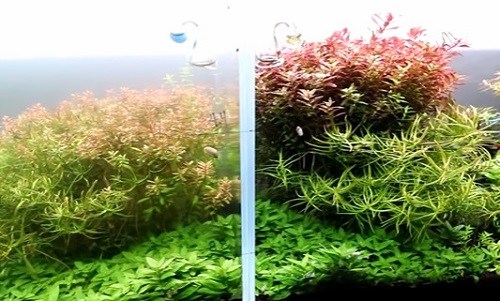 Left (no CO2), right (with CO2), 40 days post-trim
Left (no CO2), right (with CO2), 40 days post-trim
Signs of Deficiency:
- Slow growth
- Carpet plants stalling out
- Fading leaf colors
- Plants dropping leaves and dying off
Solutions:
- Boost aeration and water movement
- Add a pressurized CO2 system
- Use bioavailable carbon like Seachem Flourish Excel #ad
- Toss in more fish for natural CO2
Nitrogen (N)
Role: Nitrogen’s a big deal—second only to carbon. It’s in amino acids, chlorophyll, and plant hormones. Plants grab it as nitrate (NO3-) or ammonium (NH4+) from fish waste and decay. Low fish count? Nitrogen might run dry.
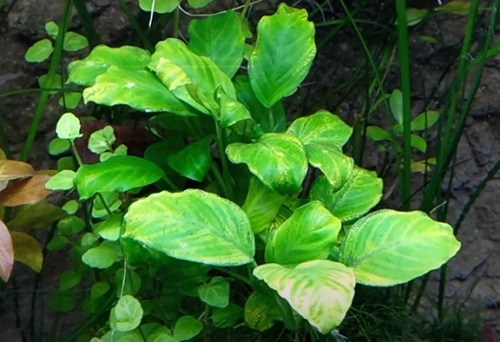 Nitrogen-starved leaves
Nitrogen-starved leaves
Signs of Deficiency:
- Sluggish growth
- Yellow, see-through older leaves
- Tiny, stunted new leaves
- Fuzzy or hairy algae takeover
Solutions:
- Add a nitrogen supplement #ad
- Bring in more fish
Phosphorus (P)
Role: Phosphorus, as phosphate (PO4 3-), powers ATP for energy and builds DNA and RNA. It comes from waste breakdown, but heavy plant loads with few fish can leave it scarce.
Signs of Deficiency:
- Crawling growth
- Dark or purple leaves
- Dead spots on older leaves
- Twisted, puny new shoots
Solution:
Potassium (K)
Role: Potassium (K+) is a photosynthesis MVP, driving metabolism and soaking in through leaves. It’s super soluble—plants love it fast.
Signs of Deficiency:
- Yellowing leaves
- Holes in leaves
- Slowed growth
Solution:
- Grab a potassium supplement #ad
Calcium (Ca)
Role: Calcium (Ca2+) builds cell walls, aids division, and tweaks nitrates. Soft or RO water can starve plants—boost hardness with crushed coral to keep it steady. Lucky us, it’s rarely an issue!
Signs of Deficiency:
- Twisted new leaves
- Stunted growth
- Withered leaf tips
Solutions:
- Switch to tap water over RO/DI
- Remineralize RO with Seachem Equilibrium #ad
- Add crushed coral for hardness
Magnesium (Mg)
Role: Magnesium (Mg2+) fuels photosynthesis, protein, and DNA creation—shining in new growth zones. It’s enzyme central!
Signs of Deficiency:
- Pale patches between dark veins on old leaves
- Crippled growth
Solutions:
- Most ferts have magnesium—check yours
- Try Epsom salt (magnesium sulfate)
- Use Seachem Equilibrium #ad
Other Macronutrients: Oxygen, hydrogen, and sulfur come easy from water and substrate. Sulfur (as sulfate) keeps chlorophyll pumping.
Micronutrients
Iron (Fe)
Role: Iron’s the micro king—used tons in photosynthesis and electron shuffling (Fe2+ or Fe3+). It’s everywhere in tanks, but plants only sip trace amounts.
Signs of Deficiency:
- Yellow or white patches between leaf veins
- Black spots or holes in new leaves
Solutions:
- Iron-packed root tabs
- Iron-rich clay
- Aquarium iron ferts
Manganese (Mn)
Role: Manganese (Mn2+) powers photosynthesis, respiration, and root growth—second only to iron in demand. It’s tricky—looks like iron deficiency if low.
Signs of Deficiency:
- Sluggish shoots and roots
- Yellow leaves, green veins
Solutions:
- All-in-one ferts
- Micronutrient supplements
Other Micronutrients: Boron toughens cell walls, zinc builds proteins, copper boosts defenses, and molybdenum aids nitrogen use—tiny but mighty helpers!
Comparison Table: Fertilizers and Root Tabs
| Model | Our Rating | Nutrients | Ideal For | Usage | Bottle/Pack |
 |
 Seachem Flourish Freshwater Plant Supplement #ad Seachem Flourish Freshwater Plant Supplement #ad |
Macro + Micro | Beginners, tanks with fish | 1 capful (5 ml) per 20 Gal (80 L) | 8.5 fl. oz. |
 |
 Seachem Flourish Growth Supplement Tabs #ad Seachem Flourish Growth Supplement Tabs #ad |
Macro + Micro | Beginners, tanks with fish | 1 tab per 4-6″ (10-15 cm) radius, every 3-4 months | 10 tabs |
 |
 Thrive+ All in One Liquid Aquarium Fertilizer #ad Thrive+ All in One Liquid Aquarium Fertilizer #ad |
Rich Macro + Micro | Dense tanks, few/no fish | 1 pump per 10 Gal, 1-3x/week | 500 ml (pump) |
 |
 Thrive S Shrimp Specific All in One Aquarium Fertilizer #ad Thrive S Shrimp Specific All in One Aquarium Fertilizer #ad |
Macro + Micro, Copper-Free | Shrimp tanks | 1 pump (1 ml) per 5 Gal, 1-3x/week | 500 ml (pump) |
 |
 Seachem Flourish Excel Bioavailable Carbon #ad Seachem Flourish Excel Bioavailable Carbon #ad |
Carbon + Iron | No-CO2 tanks | 5 ml per 10 Gal, daily | 16.9 fl. oz. |
 |
 NilocG Aquatics Liquid NPK+M aquarium fertilizer #ad NilocG Aquatics Liquid NPK+M aquarium fertilizer #ad |
Macro + Micro (2 bottles) | EI dosing, precise needs | 1 pump per 10 Gal, 1-3x/week | 500 ml each (pump) |
 |
 Fluval Plant Gro+ Micro Nutrient for Aquariums #ad Fluval Plant Gro+ Micro Nutrient for Aquariums #ad |
Macro + Micro, Iron-Rich | Beginners, fish-heavy tanks | 5 ml per 60 Gal | 8 fl. oz. |
 |
 API Root Tabs Freshwater Aquarium Plant Fertilizer #ad API Root Tabs Freshwater Aquarium Plant Fertilizer #ad |
Macro + Micro | Beginners, tanks with fish | 1 tab per 30 sq. in. | 10 tabs |
 |
 API Leaf Zone Freshwater Aquarium Plant Fertilizer #ad API Leaf Zone Freshwater Aquarium Plant Fertilizer #ad |
Iron + Potassium | Yellow, decaying leaves | 5 ml per 10 Gal, weekly | 16 fl. oz. (cap) |
 |
 API CO2 Booster Freshwater Aquarium Plant Treatment #ad API CO2 Booster Freshwater Aquarium Plant Treatment #ad |
CO2 + Carbon | No-CO2 tanks | 1 ml per 10 Gal, daily | 16 fl. oz. |
 |
 Aquarium Plant Root Fertilizer Tabs 40 Count #ad Aquarium Plant Root Fertilizer Tabs 40 Count #ad |
Macro + Micro | Beginners, tanks with fish | 1 tab per 3-6 sq. in., every 3 months | 40 tabs |
 |
 Aqueon Aquarium Plant Food #ad Aqueon Aquarium Plant Food #ad |
Macro + Micro | Beginners, tanks with fish | 10 ml per 10 Gal, weekly | 17 fl. oz. (cap) |
Note: Most ferts lean light on macros—fish waste covers that in tanks with livestock. For dense, fishless setups, go macro-heavy to fuel the jungle!
Best Aquarium Plant Fertilizers Reviewed
Seachem Flourish Freshwater Plant Supplement

 Check on Amazon #ad
Check on Amazon #ad- Nutrients: Macro + Micro
- Ideal For: Beginners, tanks with fish
- Usage: 1 capful (5 ml) per 20 Gal
- Bottle: 8.5 fl. oz.
Seachem Flourish is your all-in-one rookie MVP—loaded with micros, minerals, and phytohormones to kick roots and shoots into gear. Calcium, magnesium, iron—you name it, it’s in there, with a formula that boosts uptake and fights disease. Shrimp-safe and perfectly dosed, one capful keeps a 20-gal tank humming without overdose drama.
Seachem Flourish Growth Supplement Tabs

 Check on Amazon #ad
Check on Amazon #ad- Nutrients: Macro + Micro
- Ideal For: Beginners, tanks with fish
- Usage: 1 tab per 4-6″ radius, every 3-4 months
- Packet: 10 tabs
Flourish Tabs are root rocket fuel—pop one in the gravel, and watch the magic unfold. Packed with calcium, potassium, and vitamins, they release nutrients slow and steady. Ten tabs cover a 15-gal tank—perfect for newbies craving fast results!
Thrive+ All-in-One Liquid Aquarium Fertilizer

 Check on Amazon #ad
Check on Amazon #ad- Nutrients: Rich Macro + Micro (analysis)
- Ideal For: Dense tanks, few/no fish
- Usage: 1 pump per 10 Gal, 1-3x/week
- Bottle: 500 ml (pump)
Thrive+ from NilocG is a beast for plant-packed tanks—nitrogen, phosphate, iron, the works. One pump per 10 gallons (up to 2,500 gal total!) keeps low- or high-tech setups thriving. Safe for all critters, it’s enthusiast-grade fuel.
Thrive S Shrimp-Specific All-in-One Aquarium Fertilizer

 Check on Amazon #ad
Check on Amazon #ad- Nutrients: Macro + Micro, Copper-Free (analysis)
- Ideal For: Shrimp tanks
- Usage: 1 pump (1 ml) per 5 Gal, 1-3x/week
- Bottle: 500 ml (pump)
Thrive S is shrimp heaven—no copper, just balanced macros and micros. One pump per 5 gallons feeds plants without stressing your tiny crew. Hassle-free and effective—NilocG nails it again!
Seachem Flourish Excel Bioavailable Carbon

 Check on Amazon #ad
Check on Amazon #ad- Nutrients: Carbon + Iron
- Ideal For: No-CO2 tanks
- Usage: 5 ml per 10 Gal, daily
- Bottle: 16.9 fl. oz.
Flourish Excel is your CO2 hack—bioavailable carbon plus ferrous iron for lush growth sans gas systems. Daily 5-ml doses stabilize pH and keep low-CO2 plants happy. A game-changer for simplicity!
NilocG Aquatics Liquid NPK+M Aquarium Fertilizer

 Check on Amazon #ad
Check on Amazon #ad- Nutrients: Macro + Micro (2 bottles)
- Ideal For: EI dosing, precise needs
- Usage: 1 pump per 10 Gal, 1-3x/week
- Bottle: 500 ml each (pump)
NilocG’s NPK+M duo is EI-method gold—two bottles (macro and micro) for custom dosing. One pump of each per 10 gallons, thrice weekly, and your plants are dialed in. Precision lovers, this one’s for you!
Fluval Plant Gro+ Micronutrient for Aquariums

 Check on Amazon #ad
Check on Amazon #ad- Nutrients: Macro + Micro, Iron-Rich (analysis)
- Ideal For: Beginners, fish-heavy tanks
- Usage: 5 ml per 60 Gal
- Bottle: 8 fl. oz.
Fluval Gro+ brings 30 years of trust—iron-packed with vitamin B for vigorous growth. A light 5-ml dose per 60 gallons suits fishy tanks perfectly. Simple and solid from a top name!
API Root Tabs Freshwater Aquarium Plant Fertilizer

 Check on Amazon #ad
Check on Amazon #ad- Nutrients: Macro + Micro
- Ideal For: Beginners, tanks with fish
- Usage: 1 tab per 30 sq. in.
- Packet: 10 tabs
API’s Root Tabs—50 years of expertise in every tab. Iron, potassium, and carbon supercharge roots monthly. One tab per 30 square inches, and your plants are set to soar!
API Leaf Zone Freshwater Aquarium Plant Fertilizer

 Check on Amazon #ad
Check on Amazon #ad- Nutrients: Iron + Potassium
- Ideal For: Yellow, decaying leaves
- Usage: 5 ml per 10 Gal, weekly
- Bottle: 16 fl. oz. (cap)
Yellow leaves? API Leaf Zone’s got you—chelated iron and potassium soak in fast through leaves, reviving bushy growth. Weekly 5-ml doses per 10 gallons turn decay into dazzle!
API CO2 Booster Freshwater Aquarium Plant Treatment

 Check on Amazon #ad
Check on Amazon #ad- Nutrients: CO2 + Carbon
- Ideal For: No-CO2 tanks
- Usage: 1 ml per 10 Gal, daily
- Bottle: 16 fl. oz.
API CO2 Booster is lushness in a bottle—daily carbon doses for tanks without CO2 rigs. Safe for fish and inverts, it’s a slow-release win solo or paired with systems!
Aquarium Plant Root Fertilizer Tabs (Budget Pick)

 Check on Amazon #ad
Check on Amazon #ad- Nutrients: Macro + Micro
- Ideal For: Beginners, tanks with fish
- Usage: 1 tab per 3-6 sq. in., every 3 months
- Packet: 40 tabs
Budget-friendly and gravel-ready, these tabs drip-feed nutrients for three months. Space them 3 inches apart—perfect for newbies wanting big growth on a small dime!
Aqueon Aquarium Plant Food

 Check on Amazon #ad
Check on Amazon #ad- Nutrients: Macro + Micro
- Ideal For: Beginners, tanks with fish
- Usage: 10 ml per 10 Gal, weekly
- Bottle: 17 fl. oz. (cap)
Aqueon’s a trusted classic—potassium, iron, and kelp heal plants and boost resilience. Weekly 10-ml doses per 10 gallons (copper-free!) keep fish and shrimp safe and plants popping!
Recommended Water Parameters and Nutrient Levels
| Parameter | Testing Methods | Target | |
| Water | Temperature | Thermometer | 75-80°F (24-27°C) |
| pH | pH meters, litmus paper | 6.0-7.5 | |
| Ammonia, Nitrite | Test kits | 0 ppm | |
| Hardness | GH & KH test kits | 3-8 dGH, 3-8 dKH (guide) | |
| Macronutrients | CO2 | Drop checker | 25-30 ppm (guide) |
| Nitrate | Nitrate test kits | 20-30 ppm | |
| Phosphate | Phosphate test kits | 1-2 ppm | |
| Potassium | Test kits | 5-10 ppm | |
| Calcium | Calcium test kits #ad | > 30 ppm (or 3-8 dGH) | |
| Magnesium | Magnesium test kit or formula below | 5-10 ppm | |
| Micronutrients | Iron | Iron test kits | 0.1-0.5 ppm (varies by biomass) |
| Other trace elements | Plant symptoms | Normal growth |
Formula: dGH = (4.1 x Mg ppm) + (2.5 x Ca ppm) / 17.86 => Mg ppm = [dGH x 17.86 – (2.5 x Ca ppm)] / 4.1
1 dGH = 4.36 mg/L Mg or 7.14 mg/L Ca
How to Dose Aquarium Fertilizers Right
Stick to the label—it’s the safest bet! Dose 2-3 times weekly post-water change so plants soak up nutrients before the next refresh. Pair an all-purpose liquid with iron and trace boosters—your plants will thank you. Fast-growers show deficiencies in days, slow ones in weeks—watch the speedsters for early clues. Skip the guesswork; fix issues with proven solutions, not random tweaks!
Frequently Asked Questions
What Are Mobile vs. Immobile Nutrients?
Mobile nutrients (N, P, K, Mg, S) move from old leaves to new ones when scarce—deficiencies hit mature leaves first. Immobile ones (Ca, Fe, Zn, Cu, Mn, B, Mo) stay put, stunting new growth. Chelating agents help fix immobile shortages!
Can I Use Agri-Charts for Aquariums?
They’re handy but tricky—don’t jump to nutrient fixes for every yellow leaf. Check water, CO2, and tank stability first. Charts are a last resort after ruling out the basics.
How Often Should I Fertilize?
Follow product guides, but tweak for your tank’s plant load. Hungry plants need more; overdoing it risks algae. Test water to match daily plant needs—balance is key!
Are Fertilizers Fish-Safe?
Yep—most are shrimp- and fish-friendly, steering clear of copper. Always check labels, but you’re usually golden!
Can I Use Soil Fertilizer?
Not unless you’re a pro—soil ferts work but demand constant monitoring. Stick to aquarium-safe options for peace of mind.
DIY Aquarium Fertilizer—How?
Totally doable! Mix potassium nitrate, phosphate, sulfate, chelated traces #ad, Equilibrium #ad—tailor it to your plants. It’s a pro move, though—store-bought’s safer for most.
Which Plants Skip Fertilizer?
Low-key stars like Java fern, Anacharis, Ambulia, and Water Hysteria thrive on light alone—no ferts needed. Perfect for easy tanks!

 Guaranteed analysis #ad
Guaranteed analysis #ad Guaranteed analysis #ad
Guaranteed analysis #ad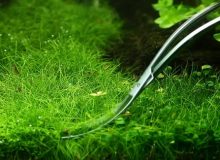
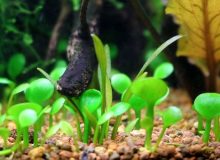
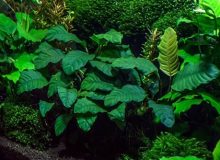
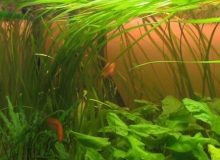
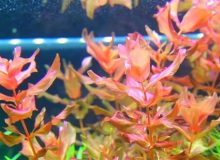
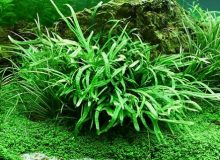
Leave a Reply